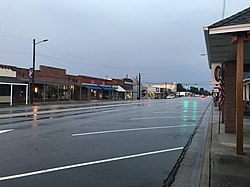2010 census
As of the 2010 United States census, there were 2,035 people living in the town. The racial makeup of the town was 48.9% White, 18.5% Black, 5.4% Native American, 0.2% Asian, 0.1% Pacific Islander, 0.1% from some other race and 1.7% from two or more races. 25.1% were Hispanic or Latino of any race.
2000 census
As of the census [5] of 2000, there were 2,137 people, 859 households, and 571 families living in the town. The population density was 1,601.2 inhabitants per square mile (618.2/km2). There were 935 housing units at an average density of 700.6 per square mile (270.5/km2). The racial makeup of the town was 25.32% White, 60.46% African American, 3.56% Native American, 0.37% Asian, 0.05% Pacific Islander, 8.14% from other races, and 2.11% from two or more races. Hispanic or Latino of any race were 14.74% of the population.
29.8% of households had children under the age of 18 living with them, 41.9% were married couples living together, 17.5% had a female householder with no husband present, and 33.5% were non-families. 30.8% of all households were made up of individuals, and 14.7% had someone living alone who was 65 years of age or older. The average household size was 2.49 people and the average family size was 3.02 members.
The median income for a household in the town was $22,347, and the median income for a family was $27,708. Males had a median income of $27,218 versus $20,750 for females. The per capita income for the town was $12,520. About 17.2% of families and 22.8% of the population were below the poverty line, including 26.4% of those under age 18 and 24.9% of those age 65 or over.
The town has an elementary school, a middle school, and a high school, all named after St. Pauls. The population was spread out, with 25.8% under the age of 18, 10.7% from 18 to 24, 28.1% from 25 to 44, 21.8% from 45 to 64, and 13.7% who were 65 years of age or older. The median age was 35 years. There were 94.8 males for every 100 females, and 89.7 males for every 100 females age 18 and over.


